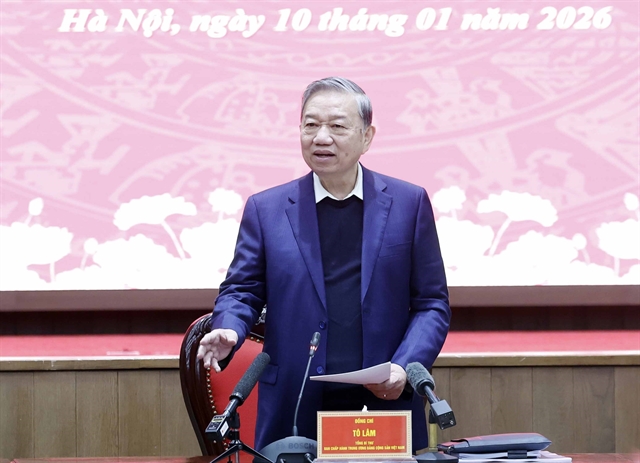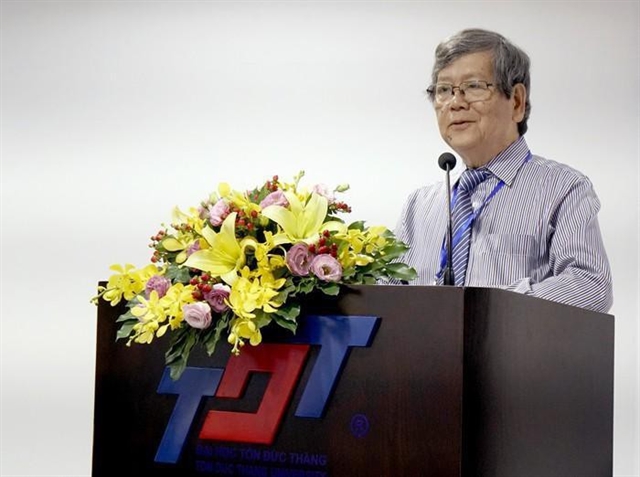 Opinion
Opinion

Vũ Ngọc Hoàng, Chairman of the Association of Universities, spoke with e-magazine giaoduc about Việt Nam’s education policies in the last decade

|
| Chairman of the Association of Universities Vũ Ngọc Hoàng. — Photo giaoduc.net.vn |
Vũ Ngọc Hoàng, chairman of the Association of Universities, spoke with e-magazine Giáo dục (Education) about Việt Nam’s education policies in the last decade
Việt Nam identified investment in education as the key to development and a top national policy. However, some say some education plans and policies have failed to follow through on this. Do you agree?
Thirty years ago, the leadership of the Party and State defined “education as the top national policy.” It showed a good strategic vision.
The historical reality of so many countries has shown that the change in mindset is the main root of breakthroughs in development.
Initially, it was excellent leaders or groups of pioneering intellectuals. It then spread to the common thinking of the whole community, creating excellent material strength for the country’s development. Such change often begins and is associated with significant educational policies and reforms.
Successful educational reforms are truly a profound and great “revolution.” The education policy as the top national policy of Việt Nam was stated very early on, but unfortunately, in reality, many strategies, plans and policies have not shown that spirit for a long time.
Our country’s financial resources for education investment are still very small, accounting for a very low proportion of GDP compared to other countries.
Việt Nam’s investment in higher education is only 0.33 per cent of GDP, and some say the rate is only 0.25 per cent of GDP.
In many countries, the investment rate for higher education is two to six times higher than that of Việt Nam. For example, in Thailand the percentage is 0.64; China 0.87; Korea 1; Singapore 1; Malaysia 1.13; Poland 1.22; France 1.25; England 1.29; Australia 1.54; New Zealand 1.63 and Finland 1.89.
Việt Nam’s average investment per student is US$316, while other countries invest two to five times higher. For examples, Indonesia is $682, Thailand $1,121, Malaysia $2,505, Singapore $11,639, Australia $12,182, and the UK $16,603.
The level of university access (enrollment rate) of students who finish high school in Việt Nam is 28 per cent, the lowest in Southeast Asia.
To truly be a top national policy, education needs to be given much more attention by the country’s leaders.
For a long time, the country’s leaders paid the education sector less attention than other sectors, except for President Hồ Chí Minh, who, as soon as the young revolutionary Government was formed, considered illiteracy, hunger and invaders as the three ‘enemies’ to fight.
What solutions are needed in education policies?
It is necessary to have a sufficient and feasible strategy for developing higher education to ensure high-quality human resources that meet the minimum requirements of an industrial country with high income in the next 20-25 years.
The investment budget for education should be clearly distinguished without adding the expenditures for other fields to education. It is also necessary to reform the investment method for schooling.
To achieve the highest efficiency with limited financial resources, the Government needs to call for investment from the private sector and international partners in education and fundamental reform in public investment.
The development of higher education is necessarily based on training to provide high-quality human resources for the country.
At the same time, the proportion of workers who have graduated from university in the social labour structure by age should also be increased. The rate in our country is currently only about 12 per cent, while in many developed countries the rates are between 32-36 per cent.
This is the first and most important criterion for a developed industrialised country with a high income. Only when the majority of labourers have good technical qualifications can we increase the values of commodities.
To make Việt Nam a developed industrialised country within the next 20-25 years, the proportion of university graduates must double to about 25 per cent. The scale of higher education will have to increase significantly and urgently.
The country does not lack workers, so we must promote vocational education.
We lack people who can combine theory and practice to meet employers’ practical requirements.
It is important to expand the training scale of universities and colleges and open many more universities. More importantly, we must control the quality of training.
Resolution No. 29-NQ/TW is a strategic resolution for the medium- and long-term goals for the education sector. After nearly nine years, no overall assessment has been published on the performance of the resolution. What do you think of the effects of the resolution?
Resolution 29 of the Central Party Committee on fundamental and comprehensive reform of education and training is a good resolution going in the right direction.
It was launched nearly 10 years ago. The respected professor Hoàng Tụy also praised this as a good resolution, and he rarely praises anything.
However, so far, there has not been any technical master plan to implement nor a strong enough national committee to decide on major issues that the Ministry of Education and Training alone cannot solve.
The renovation of education is still patchy and inconsistent, especially with some issues that are not in accordance with the spirit of the resolution. The innovation results are not significant. The basic education is still the same as the situation before the resolution was launched.
Improving the quality of education is the most important and most consistent requirement in the spirit of Resolution 29. However, it is still not clear how we have improved. There are many things and problems that go contrary to its spirit. For example, a lowering of standards to increase quantity and revenue, examination cheating, education management fraud, and teachers not following the code of ethics.
Quality is one of the first characteristics of education. Education is about improving the quality of human resources. Education is for the quality of a community, of a nation. Even mass education is for improving the quality of the community.
The problem of quantity in education is also because of quality. Quantity must be associated with quality. Without sufficient quality, education is no longer education and become useless. Education reform has the first and foremost purpose of improving the quality of educational activities.
The question now is, since the resolution was launched, what we have done to ensure and improve quality?
It is necessary to look back and find specific solutions to improve the quality of the whole country’s education system.
The two most significant tasks are reforming the educational programme in general education and implementing autonomy in universities. However. it seems that both of these things have not achieved the expected results. — VNS